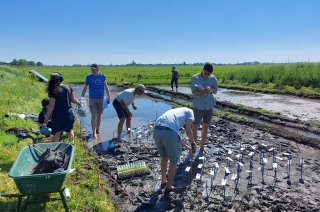
category_news
Polder rice in the Netherlands: will it succeed this year?
Will it succeed this year to grow ‘polder rice’ in the Netherlands for the first time? Researchers at Wageningen University & Research (WUR) and Leiden University are giving it another shot. Whereas the yield last year was minimal, this year the researchers work with 32 different rice varieties adapted to the cooler climate of the Netherlands.
The project is a collaboration between researchers from the Plant Sciences Group (Tom Schut), Animal Sciences Group (Aart van der Linden) and Environmental Sciences Group (Julian Helfenstein) of WUR, and Maarten Schrama of Leiden University.
In May last year, the researchers planted 3,000 rice plants of one variety. The researchers wanted to try rice as a nature-based solution for future sustainable peat management: the crop allows raising the water table and produces food at the same time.
Julian Helfenstein (WUR): ‘Last year we started testing with rice. You should see it more as a hobby project with one type of rice coming from northern Italy. The plant did grow, but the harvest was minimal. This year, we will start working with 32 different varieties of rice. These varieties were selected out of 19000 rice varieties maintained by GRIN-Global Plant Germplasm in the USA. We selected these varieties of rice because they are most likely to be suitable for the climate in the Netherlands. The varieties come from Japan to Uzbekistan, to China, and have interesting names such as Tomohikari (‘shining together’, Japanese) and Sputnik (Russia). So this summer we are going to see how they do in the Netherlands.’
Interesting crop for the Netherlands
Transforming agriculture on peatlands is perhaps one of the biggest challenges facing the Dutch agricultural sector. By investigating the potential of rice cultivation, the researchers aim to widen the solution space with a new, innovative path that could reduce environmental problems, contribute to more circular food production and provide new habitats for bog species.
The researchers are testing rice because the crop grows well on flooded land and could therefore be of interest to the Netherlands. For instance, the crop could halt peat mineralisation and subsidence. Also, problems with seawater intrusion and salinisation could be mitigated by higher groundwater levels. Moreover, wet rice fields could provide a valuable habitat for wetland species such as amphibians and dragonflies.
Fish with rice?
In a separate experiment, a researcher is testing whether it is possible to farm fish on the rice paddy. The researchers are aware that in the longterm rice cultivation is only an option if it is financially attractive for farmers. Fish farming could provide an additional source of income for farmers. The researchers expect the rice field to provide an attractive habitat for the fish, while the fish in turn are positive for the rice as they leave nutrients in the water.
Aart van der Linden (AFS): ‘Growing sustainable, local rice and fish is interesting because it can be sold at a premium, contributes to a more circular agriculture and reduces emissions from current peatland agriculture. Moreover, rice farming benefits from warming temperatures, so it can be both an adaptation to and mitigation of climate change. Once we have secured the necessary funding, we intend to go further and optimise the agronomy and monitor the impacts on greenhouse gases, nutrient fluxes, water regulation and biodiversity to identify the best management options.’
When will what take place?
The first rice plants were planted by hand this week; the machine planting will start next Monday, 19 May, and 2 weeks later the fish are put in the water. Harvesting will be in September.